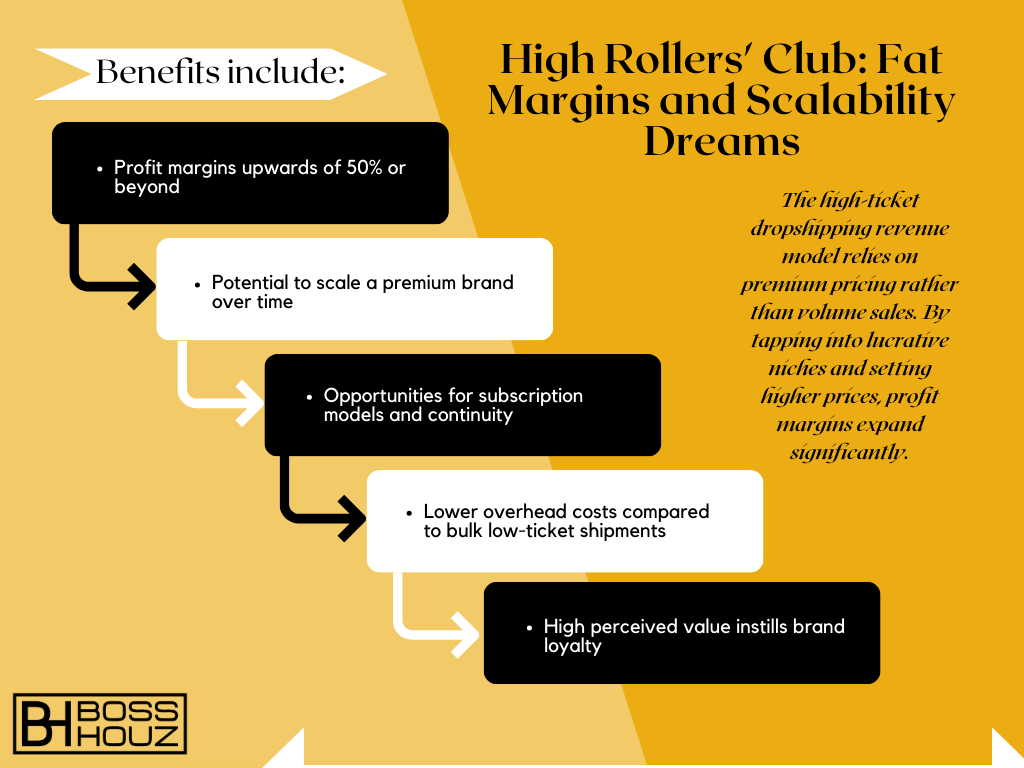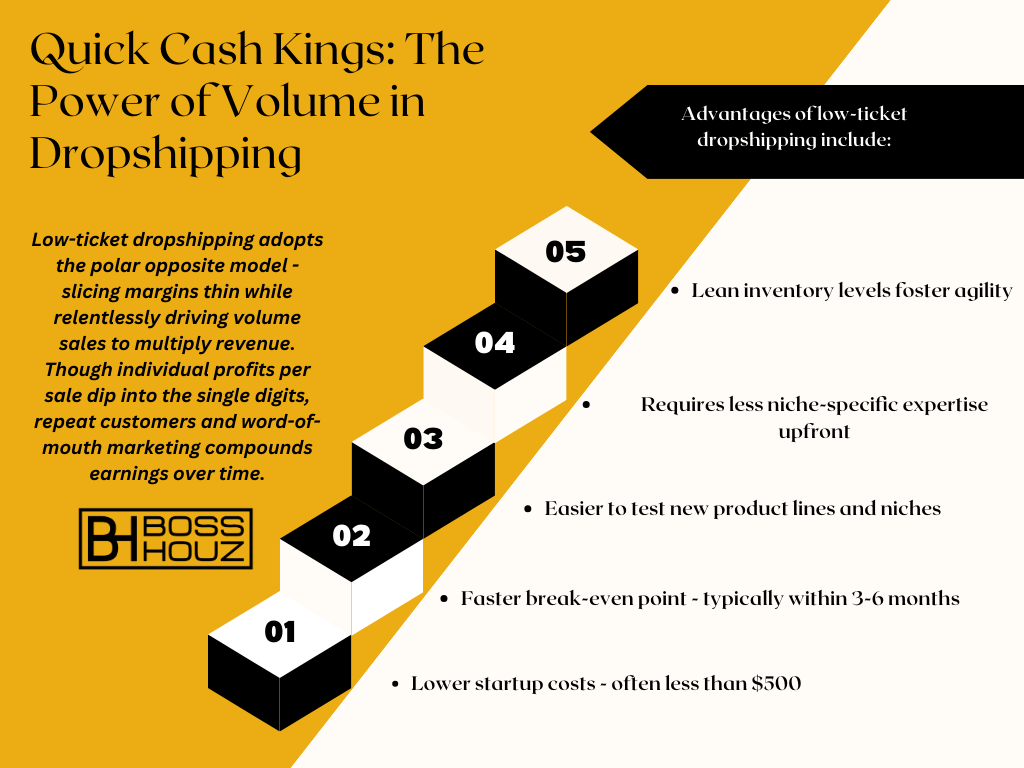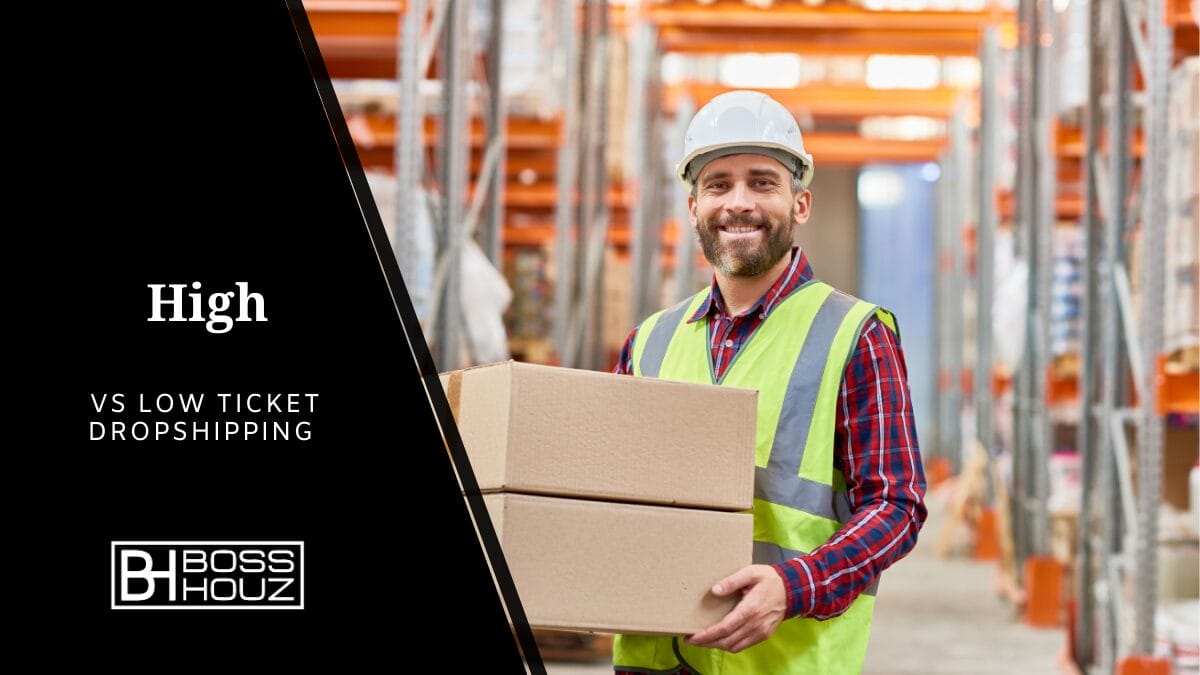Table of Contents
Deciphering the Difference: Big Bucks vs Bustles of Sales
When you start your journey with dropshipping, one of the first decisions you’ll encounter is whether to focus on high-ticket or low-ticket items. At a basic level, high-ticket dropshipping involves selling higher-priced products – think $100+ per item – often focused within niche markets. This contrasts with low-ticket dropshipping centred around affordable impulse buys usually priced under $50.
So what does this difference mean for your prospective online business? Here’s an overview of the core distinctions:
- Profit Margins:High-ticket items enable larger margins per sale, sometimes 50% or higher. With low-ticket products, margins tend to range from 10-30% due to competitive pricing and higher sales volume requirements.
- Volume vs Value:Low-ticket success hinges on high sales volume – selling thousands of lower-priced items. High-ticket focuses exclusively on value over volume, with far fewer but more lucrative sales.
- Customers:High-ticket attracts very targeted, often niche clientele willing to pay premium prices. Low-ticket casts a wider net to capture impulse purchasers across diverse demographics.
Clearly, both models have distinct financial possibilities – but also very different business implications in areas like branding, marketing, and long-term sustainability.
Niche Showdown: Luxury Gems vs Everyday Treasures
Drilling down further, high and low ticket dropshipping attract different target audiences, meaning niche selection is key.
Exclusive high-end markets like custom jewelry, niche artworks, or bespoke outdoor gear open doors to discerning clientele ready to pay top dollar. Key traits of high-ticket niches include:
- Specialist target audience
- Premium positioning
- High perceived value
- Low price competition
- Loyal customer base
On the flip side, low-ticket products often fall into everyday essential categories with broad mainstream appeal and frequent purchase cycles:
- Phone accessories
- Homewares
- Beauty, health, and wellness
- Pet supplies
- Apparel and fashion
With their mass market potential and fast-moving inventory, these lower-priced niches drive profits through sheer quantity over individual value.
Clearly, niche selection plays a pivotal role in dictating target customers, marketing tactics, and revenue models for high vs low ticket dropshipping. Choose wisely!
Profit Palaces and Bargain Bonanzas: Unveiling the Financial Landscapes
For any business, long-term profitability is imperative. So what’s the real deal when it comes to potential earnings across high and low-ticket dropshipping? Let’s crunch the numbers.
High Rollers’ Club: Fat Margins and Scalability Dreams


The high-ticket dropshipping revenue model relies on premium pricing rather than volume sales. By tapping into lucrative niches and setting higher prices, profit margins expand significantly.
Benefits include:
- Profit margins upwards of 50% or beyond
- Potential to scale a premium brand over time
- Opportunities for subscription models and continuity
- Lower overhead costs compared to bulk low-ticket shipments
- High perceived value instills brand loyalty
However, to really capitalize on five-figure profits and beyond, significant upfront investments are often required for things like:
- Niche-specific inventory
- High-quality branding
- Custom website development
- Targeted marketing outreach
For these reasons, true high-ticket dropshipping products works best for patient entrepreneurs with deeper pockets. Expect a longer runway to profitability, but with handsome rewards for well-executed hustle.
Quick Cash Kings: The Power of Volume in Dropshipping


Low-ticket dropshipping adopts the polar opposite model – slicing margins thin while relentlessly driving volume sales to multiply revenue.
Though individual profits per sale dip into the single digits, repeat customers and word-of-mouth marketing compounds earnings over time.
Advantages of low-ticket dropshipping include:
- Lower startup costs – often less than $500
- Faster break-even point – typically within 3-6 months
- Easier to test new product lines and niches
- Requires less niche-specific expertise upfront
- Lean inventory levels foster agility
Critically however, low-ticket success hinges on reach and conversions to profit – needing thousands of sales monthly to thrive. Standing out in hyper-competitive niches brings its own challenges.
For bootstrapping entrepreneurs or anyone seeking to validate an ecommerce business on a budget however, low-ticket dropshipping remains tough to beat – delivering quick cash potential despite wafer-thin margins.


Marketing Masterclass: Attracting Your Ideal Tribe
Now that the device and models are clearer, what about attracting an audience? Marketing mechanics differ greatly across high vs low-ticket dropshipping…
Whispering to Whales: Tailoring Strategies for High-Ticket Hunters
High-ticket customers demand exclusivity and personalization exceeding everyday ecommerce shoppers.
To attract your ideal whales, employ bespoke marketing strategies like:
Influencer Partnerships: Align with niche thought leaders, collaborating on limited capsule collections or exclusive VIP drops for their engaged audiences. The influencer halo effect helps attract fellow high-ticket shoppers.
Paid Ads in Premium Channels: Avoid mainstream display networks, instead focusing paid ad budgets on upmarket publications and social platforms aligned with luxury lifestyles. Geographic and income targeting helps laser focus your spending.
Content Marketing:Blog posts, guides and rich media surrounding niche lifestyles build authority while nurturing desire for associated premium products you sell – especially effective on platforms like Pinterest.
Referral Programs: Word-of-mouth rules the high-end space. Reward existing customers for making introductions within their networks to foster organic social buzz.
The keys are tapping into privilege and building an aura of aspirational exclusivity – the very factors high-ticket buyers crave.
Casting a Wide Net: Hooking the Impulse-Driven Crowd
Low-ticket dropshipping adopts the diametric opposite approach, employing high-volume marketing to maximize reach and conversions.
Tactics include:
- Facebook & Instagram Ads: Visual commerce thrives on these platforms. Laser targeted campaigns with video ads grab impulse shoppers scrolling feeds.
- Influencer Seed Programs: Send free products to armies of micro or nano influencers to generate initial traction. Their authentic, grassroots promotions build credibility.
- SEO Blogging:Article marketing attracts visitors from Google and other search engines. Optimize blogs around buyer keywords through detailed guides, listicles and tips building your niche authority.
- Email Marketing: Segmented email nurture tracks move window shoppers down the funnel, while cart abandonment flows re-target lost sales – recovering thousands in potential revenue.
The mantra echoes across all marketing channels: velocity over value. Buzz fuels further buzz, compounding sales momentum.
Inventory Intrigue: Stocking Your Dropshipping Empire
Managing in-demand inventory supplies the engine for both high and low-ticket dropshipping. But what works best for each model? Let’s investigate…
The Luxe Life: Sourcing Treasures for Discerning Clientele
Catering to premium buyers mandates working exclusively with high-end suppliers or private label partners capable of upholding exceptional quality standards.
Ideal inventory sources include:
- Boutique marketplaces like Spocket feature elite dropshipping suppliers across multiple luxury niches – lowering risks.
- Private label manufacturing gives full quality control while enabling high retail markups – projected to grow enormously.
- Direct-to-brand partnerships enable custom packaging while conveying elite brand associations – great for establishing category authority fast while benefiting from the halo effect.
With selectivity overseeing inventory in the high-ticket world, source products catering specifically to your niche target audience. Curate offerings aligning with their affluent expectations and willingness to pay premiums.
Fast and Furious: Keeping Up with the Quick-Fire Flow
In comparison, low-ticket dropshipping relies less on exclusivity – instead demanding rapid access to latest mainstream or mass market best-selling products. Custom branding and packaging matter less if prices stay affordable.
Optimizing for this fast-paced inventory flow means leveraging established B2B platforms like:
- AliExpress: Its vast supplier network spanning countless everyday niches keeps low-ticket stores continually stocked with a firehose
of on-trend products. Just-in-time fulfillment eliminates upfront inventory risks.
- Spocket: This Shopify-friendly dropshipping platform offers simplified supplier onboarding and order management – especially helpful for lean ecommerce stores. Pre-vetted suppliers ensure reliable order fulfillment.
- Automated Inventory Tools: Apps like Dropified feed product catalogs from AliExpress and other platforms into your store. Automatic inventory updates propagate the latest items while removing out-of-stock SKUs.
The mantras for the low-ticket world are accessibility, affordability and abundance. Carrying too few everyday products risks losing sales to competitors. Automation and agile restocking help smaller ecommerce merchants keep shelves perpetually stocked.
Eco-Empires: Can Dropshipping Be Sustainable (and Which Model Wins)?
With eco-consciousness growing among consumers, what sustainability implications do high vs low-ticket models carry? And how can dropshippers balance green priorities with profits?
On the surface, lower priced impulse purchases seem questionable through a sustainability lens – suggesting rampant waste from purchases soon discarded only to repeat the cycle.
However, lowering the carbon footprint hinges less on price points alone. Wider considerations around production ethics, materials choices and fulfillment impacts matter more.
For example, a local artisan handcrafting ceramic mugs from natural clay and renewable glazes has a vastly lower eco-impact than a distant fast fashion supplier mass-producing cheap shirts from petroleum-based fabrics.
Yet that same ceramic mug maker could operate far less sustainably than an apparel brand offsetting carbon emissions through clean energy investments.
Ultimately, entrepreneurs across high and low-ticket dropshipping can make green strides by:
- Sourcing mindfully from transparent suppliers demonstrating ethical production.
- Prioritizing natural, recycled and upcycled materials.
- Using eco-friendly packaging and fulfillment practices.
- Investing profits into environmental initiatives like forest conservation, clean energy and waste reduction programs.
The door seems wide open for innovative eco-preneurs to pursue sustainable ecommerce across both high and low-ticket niches – meeting demand while respecting ecological boundaries.


Building a Green Gold Mine: Your Sustainable Dropshipping Roadmap
Specific strategies to grow an earth-friendly dropshipping business include:
Choosing Niches: Seek markets where sustainability sells – eco fashion, vegan beauty, upcycled goods, eco homewares and beyond. Promote green credentials prominently in branding and messaging.
Curating Suppliers: Research provider practices rigorously, filtering for transparent ethics, eco-materials, ethical labor conditions, offset programs and more.
Optimizing Packaging: Replace plastic polymailers with recycled cardboard mailers, biodegradable bubble wrap, zero-waste padded envelopes and paper tape. Welcome reuse also shows customers you walk the talk!
Spotlighting Stories: Create blog and social content highlighting product backstories from design to delivery – letting makers share sustainable practices. This brings IMPACT concepts to life.
While adaptations differ across high vs low-ticket businesses, embedding eco-principles in all operations helps balance profits with planetary health – essential for long-term business success.
Scaling Secrets: From Starter Seed to E-commerce Tree
Lastly, let’s explore paths to scaling a business once initial traction takes hold. High vs low-ticket models once again diverge here:
Skyward Ascent: Strategies for Building a High-Ticket Empire
For high-ticket stores, the roadmap for structuring scale includes:
- Premium Memberships: Encourage bigger spends via exclusive buying clubs with tiered VIP benefits and luxury perks. Monthly plans increase lifetime value.
- Curated Selections: Personally source unique products unavailable elsewhere, strengthening niche authority and boosting perceived value.
- Loyalty Rewards: Entice repeat purchases via personalized points programs or pooled credit funds – applied to enable occasional epic splurges. Surprise random upgrades also delight.
- Rich Content: Build an editorial site section dedicated to your luxe niche featuring buyer guides, special reports and coffee table style lookbooks. Show your mastery while nurturing further desire and demand.
Remember, high-ticket is a marathon play toward premium positioning – not a sprint. Growth stems from providing exceptional service and products over simply chasing sales. Deliver on your superior value promise consistently.
The Power of Pennies: Growth Hacks for Low-Ticket Domination
Contrastingly for low-ticket stores, the small margins mean scaling hinges wholly on accelerating volumes to multiply revenue.
Tactics include:
- Email Sequences: Create post-purchase nurture streams informing repeat purchases. Consider promos like offering a discount on buying 3 products to incentivize higher value order sizes.
- Spin-off Stores: Launch sister sites in complementary niches once establishing traction in your original market. Cross-promote to expand reach.
- Upsells & Bundles: Suggest complementary products at checkout using smart recommendations apps to lift average cart values. People love perceived deals.
- Recurring Revenue: Offer monthly delivery subscriptions for consumable products – from health supplements to pet treats. This repeat business builds in resilient revenues with minimal added marketing expenses.
While demanding perpetual pedal-to-the-floor mentality to drive perpetually higher volumes, the low-ticket path promises a long runway for patient entrepreneurs. Additional niche stores stack revenues.
Wrapping up High vs Low Ticket Dropshipping
Deciding between high vs low ticket dropshipping ultimately depends on your personal preferences, risk appetite, niche interests, and end vision for your business. Neither model is inherently better – both offer viable paths to ecommerce success backed by countless examples.
If dreaming big of a premium brand appeals most, dive deep into specialized high-ticket niches willing to pay premium pricing. Perfect your marketing and branding for discerning consumers, while providing bespoke boutique-style experiences to cultivate loyalty. This slow and steady path reaps major financial rewards over time.
Prefer quicker wins, wider audiences and lean startup models? Choose affordable impulse purchase products, then relentlessly fine-tune marketing and operations to convert impressions into sales. Let savvy automation and cross-promotion keep driving volumes ever upwards. Though more competitive, the low-ticket approach promises quicker profitability for bootstrappers.
At the starting line, reflect on your vision before committing fully to either dropshipping model. Ultimately any well-executed business built around understanding target customers and delivering real value stands primed for prosperity. The rest just takes motivated hustle.








